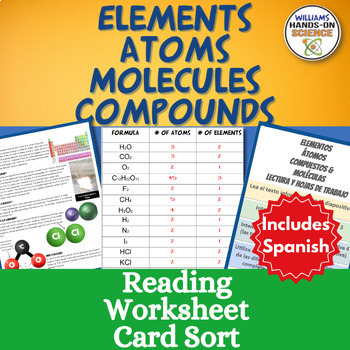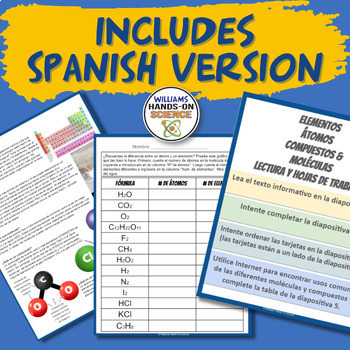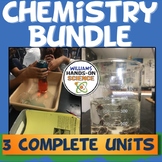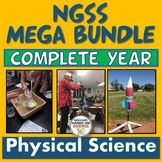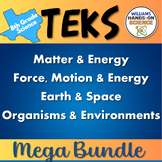Chemistry Review Curriculum Elements Atoms Compounds Molecules Spanish Digital
- Zip
- Google Apps™

What educators are saying
Also included in
- This NGSS bundle has everything you need for Structure and Properties of Matter (complete distance learning unit), PS1.B PS3.A Chemical Reactions Google Ready Bundle (complete distance learning unit) Chemical Reactions, Definitions of Energy, States of Matter, Periodic Table, Chemical Reactions, ConPrice $69.97Original Price $115.20Save $45.23
- This bundle is a time-saving, comprehensive and user-friendly complete year bundle for physical science Teachers that will streamline your teaching experience effortlessly! Every lesson is meticulously planned and just a click away. This extraordinary bundle is a treasure trove of engaging resourcesPrice $176.00Original Price $311.50Save $135.50
- The TEKS 8th Grade Bundle is a comprehensive resource for teaching science mainly in Texas, but it can be used in any state. This bundle includes over 60 hands-on, rigorous, engaging, and phenomena-driven lessons that cover the TEKS standards for 8th grade science. The lessons are designed to help sPrice $160.00Original Price $321.15Save $161.15
Description
This no prep, engaging chemistry review lesson will make your job easier and your students will know the difference between atoms, molecules, compounds and elements. And! They will learn some uses of common chemicals to put the vocabulary in context with this chemistry curriculum. AND! It includes a Spanish version!
What students do:
-Students read a one page passage on the differences between Elements, Atoms, Compounds and Molecules.
-Students attempt to sort cards under “Molecules” and “Molecules/Compounds”.
-Students count the number of atoms and elements in 13 different common chemicals.
-Students do research online and find uses for the 13 different common chemicals.
You get the following:
- Card sort, chart and key
- Close Reading
- Worksheet and Key
- Print and Digital Versions
- Spanish Version
- Teacher directions
Related Products:
States of Matter Worksheet NGSS MS-PS1: Online Lab Google Ready
MS-PS1-1 Bohr Model Atom Diagrams Structure & Properties of Matter Google Ready
NGSS Middle School Chemistry Bundle PS1.A PS1.B PS3.A PS3.B Google Ready
Periodic Table NGSS MS-PS1-1 HS-PS1 Computer Lab Google Ready
States of Matter NGSS PS1.A Science Doodle PowerPoint Google Ready
This lesson contains the following NGSS and Common Core standards:
Middle School
PS1.A: Structure and Properties of Matter: Substances are made from different types of atoms, which combine with one another in various ways. Atoms form molecules that range in size from two to thousands of atoms. (MS-PS1-1)
Each pure substance has characteristic physical and chemical properties (for any bulk quantity under given conditions) that can be used to identify it. (MS-PS1-2),(MS-PS1-3)
Gases and liquids are made of molecules or inert atoms that are moving about relative to each other.
(MS-PS1-4)
High School
PS1.A: Structure and Properties of Matter
Each atom has a charged substructure consisting of a nucleus, which is made of protons and neutrons, surrounded by electrons.
The periodic table orders elements horizontally by the number of protons in the atom’s nucleus and places those with similar chemical properties in columns. The repeating patterns of this table reflect patterns of outer electron states. (HS-PS1-1)
Science and Engineering Practices
Common Core Standard RST.6.8.7
Integrate quantitative or technical information expressed in words in a text with a version of that information expressed visually (e.g., in a flowchart, diagram, model, graph or table).
Please feel free to give me feedback and review my product.
Crosscutting Concepts
Patterns
Observed patterns of forms and events guide organization and classification, and they prompt questions about relationships and the factors that influence them.
Structure and Function
Structures can be designed to serve particular functions by taking into account properties of different materials, and how materials can be shaped and used
TEKS Science Standards:
8.5D: Recognize that chemical formulas are used to identify substances and determine the number of atoms of each element in chemical formulas containing subscripts.
TERMS OF USE
• All rights reserved by Williams Hands On Science, Inc.
• This product is to be used by the original purchaser only.
• Intended for classroom and personal use only.
• Copying for more than one teacher, classroom, department, school, or school system is prohibited.
• This product may not be distributed or displayed digitally for public view.
• Failure to comply is a copyright infringement and a violation of the Digital Millennium Copyright Act (DMCA).
If there are any errors or questions, please contact me through TpT or email me at:
williamshandsonscience@gmail.com
Thank you for taking a look!
Please follow me on TpT for new products and check me out on Instagram for my products in action!
https://www.instagram.com/williams_hands_on_science/
Related Products
⭐ NGSS 46 Slide Matter PowerPoint with Warm Ups and Guided Notes
⭐ NGSS 5E Matter Lab Computer Simulation Close Reading Close Notes & Warm Up
⭐ NGSS Molecule Building Lab (Elements, Atoms, Compounds, Molecules, Formulas)
⭐ NGSS States of Matter Doodle Notes Graphic Organizer Concept Map
⭐ States of Matter Computer Lab: Close Reading & Cloze Notes
⭐ States of Matter Warm Ups
⭐ States of Matter/Chemical & Physical Changes Dancing Raisins Lab and C.E.R.
COPY TO CLIPBOARD

